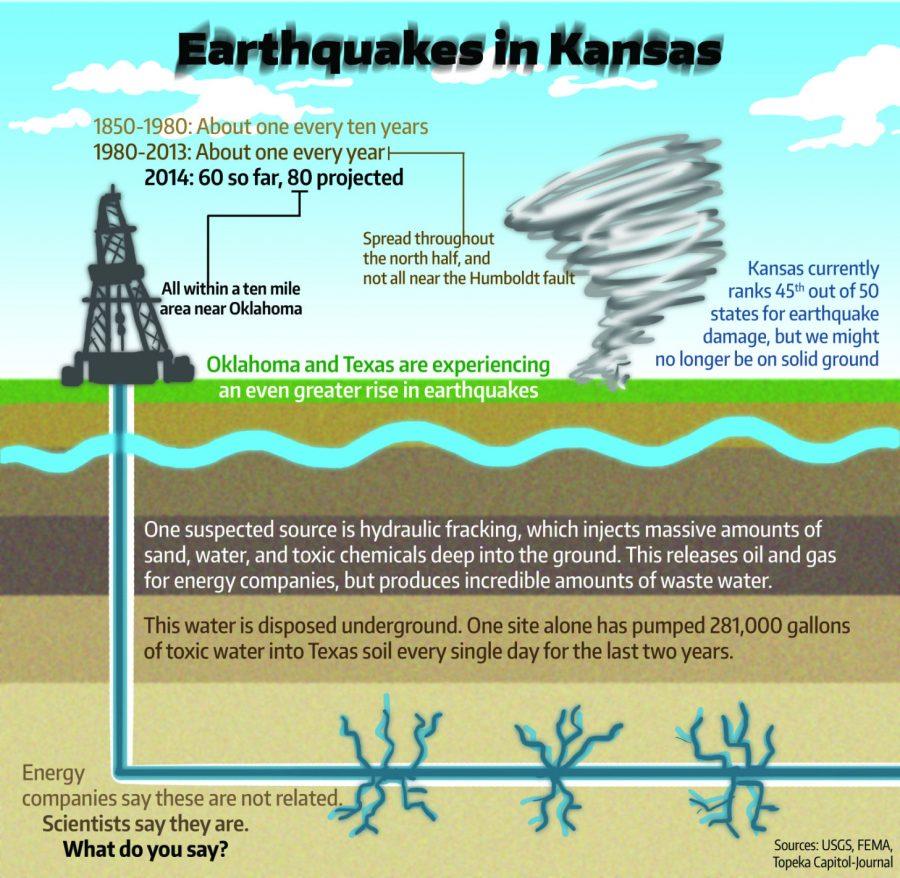Quakes shake S. Kansas, experts debate cause
October 8, 2014
It was just after 1 p.m. Oct. 2 when the shaking began in Harper, Kan. The earthquake, which measured 4.4 on the Richter Scale shook buildings, but only caused slight damage near the epicenter: the worst being cracked walls and broken picture frames. This was at least the eighth quake in three days in the area of south Kansas, and the second above 4.0.
The quakes are only the latest in a long line of earthquakes in southern Kansas over the last year, signaling a sharp increase in what is considered normal in the state. This year alone, over 50 quakes have been recorded, most of them under, or just barely around the threshold that the human body can feel, which is around 3.0.
Some have asked whether the increase in earthquakes is due to human activity, such as hydraulic fracturing, also known as fracking. Oil and gas companies use hydraulic fluids, such as a salt water mix, during drilling to induce small fractures in shale deposits underground. This allows oil or natural gas to flow to the well more easily. Some believe that the additional fracturing near a fault, such as the Humboldt fault that runs through central Kansas, can cause a surge in earthquakes.
Paul Knightly, a Kansas Environmental Geologist points out that no earthquakes have been associated with fracking until the last few years.
“It [is] more likely to me that the earthquakes are caused by wastewater injection into the deep subsurface, below and away from the water table.” said Knightly.
When the oil or natural gas is pulled from the well, a lot of the salt water comes with it. Once at the surface, it is injected back into the ground into disposal wells.
“New horizontal drilling/fracking techniques introduced recently seem to require more water than what has traditionally been used,” said Knightly, “and would explain why earthquakes have only started occurring recently.”
The spike in activity led Gov. Brownback, in February, to create an earthquake task force, which included representatives from the Kansas Geological Survey, the Kansas Corporation Commission and the Kansas Department of Health and Environment.
Last month, the task force concluded that there wasn’t enough evidence yet to link the earthquake activity to increased fracturing and urged for additional studying. The group recommended installing a permanent monitoring network in order to detect all earthquakes in Kansas with a magnitude greater than 1.5, something the state has not had in decades.
“If the injections are the source of the earthquakes, then finding a way to either reduce the volume of water used in drilling or treating and recycling the water at the surface could lead to less being pumped into the ground,” said Knightly. “It would also conserve precious water resources across the Great Plains that is also used for agricultural and domestic needs.”
Knightly says that earthquakes like the one that occurred on Oct. 2 in Harper will always be rare, and are even less likely to cause damage, but may occur more often if the injections are the primary cause.
“I would be more concerned about the amount of water used in fracking than the earthquakes themselves,” said Knightly. “The next big idea in oil would be reducing the amount of water used or wasted in drilling, and could solve the problems of water use and earthquakes simultaneously.”



